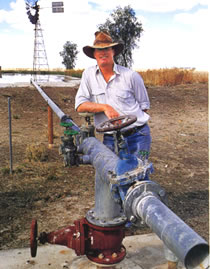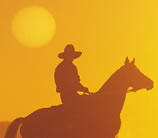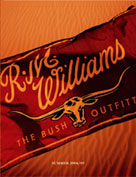OUTBACK PEOPLE
The water method man
Story Suzy Young
Photos James McEwan
 John
Seccombe's family - wife Pam and two younger children, Amanda and Jamie
- are tearing around their property's wide brown paddocks on motorbikes,
mustering for lamb marking, while overhead, in a light plane, John is swooping
around, finding mobs of sheep, pushing them in the right direction and directing
everyone by radio from the air.
John
Seccombe's family - wife Pam and two younger children, Amanda and Jamie
- are tearing around their property's wide brown paddocks on motorbikes,
mustering for lamb marking, while overhead, in a light plane, John is swooping
around, finding mobs of sheep, pushing them in the right direction and directing
everyone by radio from the air.
This is his strength - seeing the big picture, grasping the
situation, understanding the problem and working out the solution. And,
more often than not, making it happen himself.
As a grazier in western Queensland, dealing with the challenges of woolgrowing
in unpredictable times, it's a necessary talent, as it is for anyone
on the land. But John has also put his skills to work on a much larger task:
literally saving the future of rural industry in Australia.
Not surprisingly, it's uphill work. He is chairman of
the body that oversees the capping of open bores around the country that
feed from the Great Artesian Basin, the vast body of water lying under Australia
that has made agriculture and grazing possible in most of the outback. There
are, quite simply, too many bores, the water supply is under threat and
the solution - John's work - is still not fully in place because of
bureaucratic foot-dragging. Just like the water, John Seccombe's monumental,
bush-bred patience is running out.
Queensland has 70 percent of Australia's 3700 bores and the area most
in crisis, he says, is around St.George, where the pressure is dropping
by 3pc a year, which could see the water supply exhausted in just three
years years. Loss of pressure in the Great Artesian Basin, which would allow
contaminated ground water into the supply, would spell the end of the purity
of Australia's greatest resource - just as it has in many other
countries around the world. ![]()
Full story: Issue 21, February / March 02


